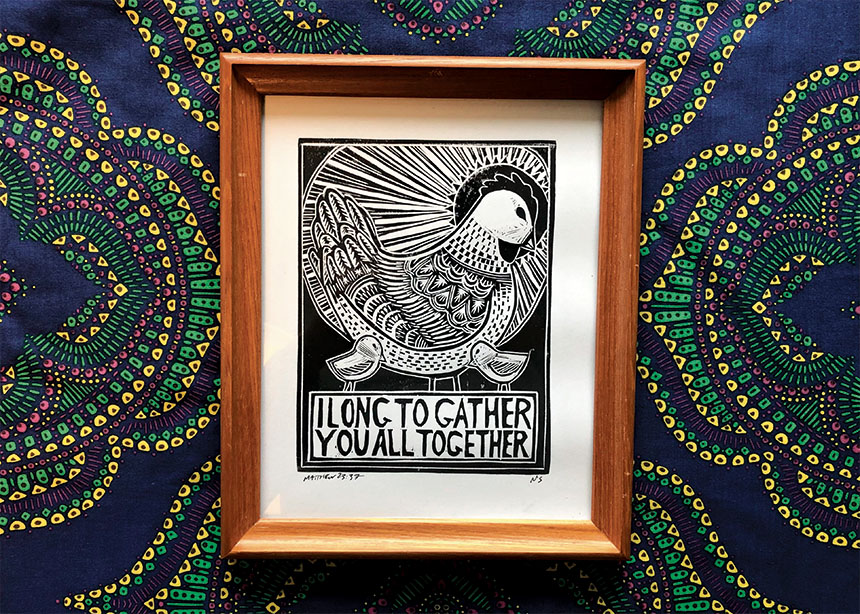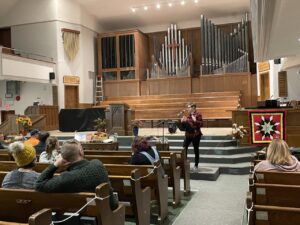With great hesitation, I pulled my car into the church parking lot. The winter morning was clear and brisk. After a short stop at a local coffee shop, Aaron and I had arrived at our destination: a local Mennonite church that was hosting a choir for “all abilities.” I had been warned about this event by the organization I work for.
The organization—let’s call it Inclusion Inc.—provides support workers for people with intellectual disabilities so they can participate in the community. “Not thrilled about it,” were my colleague’s exact words about the all-abilities choir.
As I walked into the church with Aaron, my companion, my reluctance grew.
A friendly man greeted us with fist-bumps as we entered. We hung our coats, went to the restroom and followed others into the gym. When I saw four long rows of chairs lined up in a semi-circle in front of a stage, I understood the “choir” designation was questionable; “sing-along” was closer. The cavernous gym contained tasteful Advent decorations and cheap chairs.
I began to understand why Inclusion, Inc. discourages attendance at events such as these. “Segregated programming” is the word for it in developmental services lingo. These events are focused primarily on people with cognitive disabilities rather having them “out in the community.” Programs such as these risk creating “ghettos” where people with cognitive impairments have their own “special” events, safely separated from the “normal.”
The “choir” began with everyone standing to sing the national anthem. A Christmas theme soon emerged, though no coherent order was evident as we moved from “Silent Night” to “The Twelve Days of Christmas.” At one point, the event bordered on the absurd as a gym full of people from group homes and day programs sang, and attempted to sign, “I Saw Mommy Kissing Santa Claus.”
Are we really doing this, I asked myself. What is the point? Don’t we have better things to do?
Not only did it feel “segregated,” but also potentially infantilizing, and I hate it when people with cognitive impairments are infantilized. People like Aaron have endured the indignity of labels like “perpetual child” for so long.
I felt itchy; every bit of me wanted to leave.
Beside me, Aaron seemed to be doing okay. Aaron is a man in his mid-20s. He recently moved to our city with the family that shares life with him. He loves hamburgers, fedoras, his iPad and teaching people how to slow down and be present.
Aaron must deal with the various labels placed on him by others: intellectually disabled, cognitively impaired, a person with special needs, and, most popularly, someone who has Down syndrome. Aaron spends many days being called one of these names as he navigates through society. However, I just call him Aaron.
As the person who spends days with Aaron, I also have labels, even if they are more functional. Officially I’m a “direct support person,” though sometimes I am referred to as Aaron’s “worker.” In social provision parlance, I am there to “support” Adam and help “facilitate” his daytime activities, with the goal of helping him “participate” in “community life.” In a way, these are all good goals. We can all give thanks that persons like Aaron are no longer sheltered away in institutions out in the woods for the “good” of themselves, their families and society at large. That approach is now recognized as an affront to the lives of persons labelled as disabled, and a profound loss to the broader society.
Certainly the “inclusion” my colleagues talk about is much preferable to the segregation of previous eras. Yet I find something amiss in all the high talk around “inclusion” and “diversity” that now pervades much Canadian political and social service—and strangely, ecclesial—rhetoric. In Canada, these terms—along with the trendy language of “equity”—tend to get thoughtlessly floated around, making us all feel good that by doing so we are on the “right side of history.” And this is particularly the case when it comes to Aaron.
Somehow, for many people, verbal attestations of “inclusion” illustrate how far we as a society have come in regards to those like Aaron. We are the good guys now, ushering in a society where “everyone belongs” and “everyone is welcome.”
But what does all this talk really mean? Consider “inclusion,” a favourite point of pride in several liberal and progressive Mennonite churches I have attended. Who exactly is being “included”? Who is doing the “including”? And what are the “included” being included in? I have never seen a church ask these questions.
And those churches wouldn’t be alone. Scholars have remarked how inclusion has been profoundly undertheorized, mostly being understood in the negative, as not excluding certain persons or groups. In my experience of sharing life with people with cognitive impairments, this attitude usually gets expressed as feeling sorry for “those people,” or guilt that they are not “one of us.” The solution then consists in making a space for them somewhere, assuming that they will just “fit in” and “participate” in this great new “inclusive” community we have created. This results in the persons “included” often sitting at the back, or at the front or the designated disabled seats, seemingly “included” but often—though not always—profoundly alone.
While Aaron may not understand all the subtle social dynamics going on, he can tell when sincere progressives—or liberals or conservatives or whatever you want to name yourself—“welcome” him in name only. Like many other people with impairments—or other groups targeted for “inclusion”—he simply chooses not to attend if the welcome is shallow. Aaron may implicitly know that he can never live up to the “participant” image assumed by the church. For Aaron and me, being “participants” generally means appearing and acting “Canadian.” Don’t stick out; tolerate all the current socially acceptable differences; be hygienic; don’t act like those crazies in the U.S.; be “nice” (at least to those other people acting “Canadian” enough). While I can meet the standard, many people with cognitive impairments cannot, and thus find themselves “welcomed” into spaces in which most people want to have nothing to do with them. Why would Aaron want to be a part of this? How would he ever feel at home?
Back at the “choir” session in the church gym, I actually find myself beginning to relax, perhaps with the help of Aaron, who sits calmly amidst the proceedings. As I settle into the event, I feel my sight changing, as if my eyes are adjusting to a darkened room. For amid the absurdity of the songs we sing, I notice things for the first time: obvious excitement, immense joy, raucous laughter, wild bodies. Yes, I have questions about how “appropriate” all this is, but I have to admit one thing: the vast majority of people are having a really good time! While it is not a “choir,” it certainly has a distinct feel of celebration about it.
As the excitement and chaos continue, I find myself thinking of the book of Revelation, and the “great multitude that no one could count, from every nation, from all tribes and peoples and languages, standing before the throne and before the Lamb” (7:9). Was I not only seeing, but also participating in, the heavenly throne room where the “mixed” multitude bowed in praise to Christ? In this assembly, no one is pitied for rocking back and forth in the corner; no one is considered a freak for chewing on a black telephone cord; no one is being looked at for periodic bursts of joyous (or distressing) screams.
There is no “inclusion” here, only being.
What would happen if all those who talk endlessly about “diversity” entered this space, and simply sat in attention and contemplation? For in this very unCanadian event, I think I witnessed a taste of heaven.
What a wondrous and strange kingdom this is. Are we who call ourselves Christians ready for it?
jason greig and his family live in Kitchener, Ontario. He can be reached at jfrgreig@protonmail.com. Since writing this, greig has moved from supporting people with impairments to a position in campus ministry.








Leave a Reply
You must be logged in to post a comment.